The elegant Little Princess "Fairy Fish" Culture Collection of Tropical Fish
Angelfish, also known as swallows, angels, small angelfish, small fin sail fish, etc., Cichlid fish, native to Guyana, Brazil in South America. Angelfish 12-15 cm long, up to 15-20 cm high, small head and sharp body side flat, was rhombic. The dorsal fin and anal fin are very long and large, straight as a triangular sail, so there is a small fin sail fish called. From the side to see angelfish swimming, like swallows soaring, so angelfish also known as swallow fish.

Distributed in the Indian Ocean east coast of Africa, the Red Sea, east to Australia, north to Japan, South China Sea, Taiwan Strait and other waters, is a warm water pelagic fish. Most of them live under floating objects on the sea surface. The model origin of the species is Lohaja.
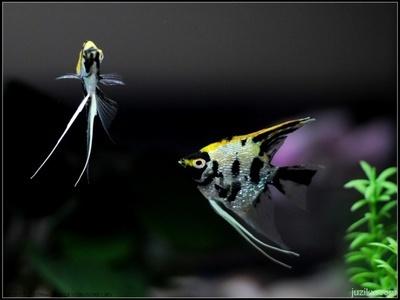
Although the fairy fish has elegant posture and beautiful posture, although it does not have bright colors, the popularity of any kind of tropical fish is unparalleled by any kind of tropical fish. It seems that a lover who has kept tropical fish for many years has not raised fairy fish. Fairy fish is almost synonymous with tropical fish. When it comes to tropical fish, people's first association is often this kind of leisurely shuttling in the aquatic plants. A fish of exuberant beauty.
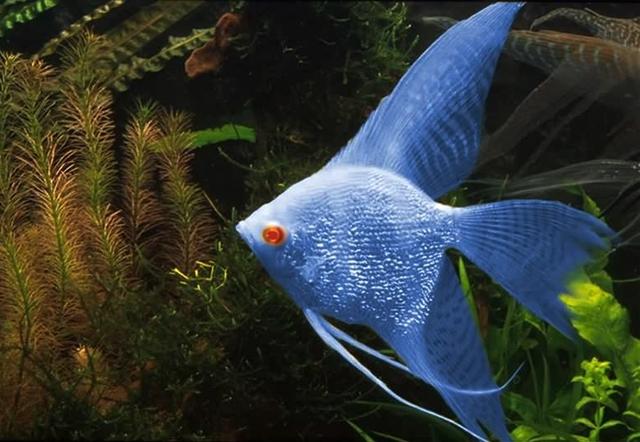
The fairy fish is not mild in character, has territorial awareness, and has no special requirements for water quality. It is best not to mix with small fish. What needs attention is the tiger skin fish of the family Cyprinidae. This naughty and lively small fish often like to bite the anal and caudal fins of the fairy fish, although it is not a fatal attack, but in order to maintain the beautiful appearance of the fairy fish, try to avoid mixing them with them.
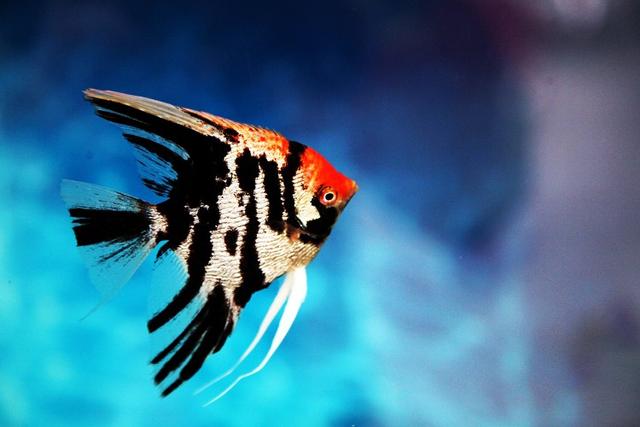
Native to Pucallpa in Peru, South America, it travels north along the Rio Ucayali and through Amazon waters to the Amazon Delta in eastern Brazil. Fairy fish can be found within a range of nearly 5000 kilometers. In addition, traces or other regional species of them are also found in Rio Negro and other tributaries. The average length of adult fish is 12-18 cm.
From the side, it is like a swallow flying, the body of the fairy fish is flattened in a diamond, and it swims like a swallow flying in the water! So it's also known as swallow fish.
First of all, freshwater fairy fish.
Colorful fairy fish
Although the colorful fairy fish is called "fairy fish", it is far from its genetic relationship with the fairy fish. (the fairy fish is the general name of the striped fairy fish P. altum, P. leopoldi and P. scalare under the fairy fish Pterophyllum, while the colorful fairy fish is the yellow brown fish S. aequifasciata fish S. discus and the Tarr fish S. tarzoo under the genus Symphysodon. Pterophyllum and Symphysodon are two different genera of the family Sparidae.
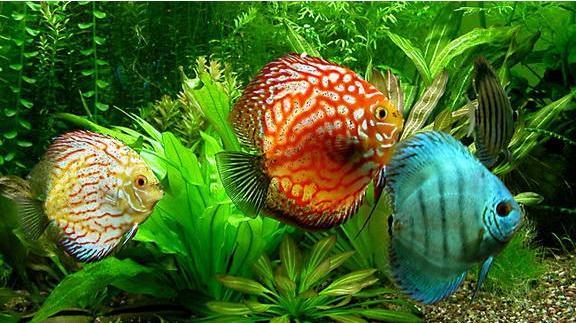
The body is 20 cm long, nearly round, flattened laterally, the tail handle is very short, and the dorsal and anal fins are symmetrical. The body is bright blue, or dark green or brown, with 8 equally spaced brown horizontal stripes from the operculum to the caudal stalk. The body color changes under the influence of light, and when the light is dark, the body color is dark; when the light is bright, the color is bright and rich, and the body is covered with stripes. It is difficult to distinguish between head, body and fin from a distance, which is very similar to the discus on the track and field, so it is called "discus" in English.
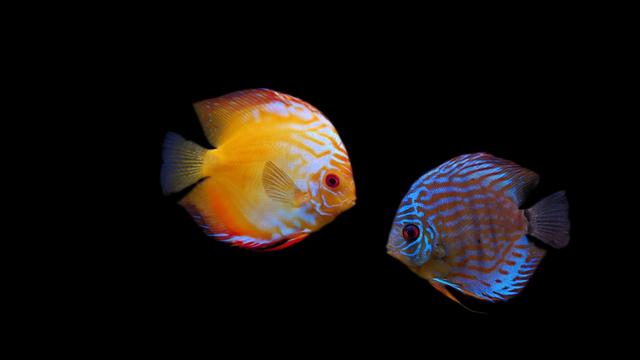
The fish body is nearly disk-shaped, flat. The body color of fish is rich and varied, with red as the main tone, brown as the main tone, blue as the main tone, and red, yellow, blue, green, black, brown, white and purple as embellishments. beautiful, known as the "tropical fish king" laudatory name.
It is not easy to feed compared with other fish. It is appropriate to use a large aquarium (more than 90 cm in length). It is best to plant dense aquatic plants in the box and place a few rocks to create a quiet and comfortable living environment. According to the relevant records, according to the classification method advocated by Mr. Heike-Blehan, the colorful immortals can be divided into two strains: wild colorful and artificial breeding. Among them, wild colorful Hegel, wild brown colorful, wild blue colorful, wild green colorful; artificial breeding colorful fish.
Colorful fairy fish, also known as discus, colorful swallow, native to the Amazon River Basin in South America, belongs to the family Sparidae in tropical fish. When tropical fish became popular more than a decade ago, people still called it "colorful fairy fish", and there were only a few varieties, called "green colorful", "blue colorful" and so on. Later, with the continuous breeding and cultivation of the fish by "fairy fish fans" all over the world, it has more and more varieties and colors, and its name is gradually upgraded to "colorful fairy fish". Such as wild colorful, brown colorful, blue colorful, green colorful, Hegel colorful, royal blue colorful, royal green colorful and so on.
Some people even joke that in a few years, it will be renamed "nine-colored fairy fish".
Colorful fairy fish are reasonably expensive, which seems to be a consensus that reporters got after visiting all the tropical aquarium shops in the Laitai Flower Trading Center. According to experts who often visit here, the price of colorful fairy fish will be more expensive mainly because of its high investment cost, because this kind of fish is a high-temperature and high-oxygen fish with stringent requirements on water quality and bait, and it is not easy to raise it. As for purebred breeding, it is even more precious that things are scarce. Even if money is spent enough and time is long enough, there are by no means a few unsuccessful. However, some people believe that the reason why colorful fairy fish is expensive, can not be separated from artificial hype, but for good fish species, we still agree that it is worth it.
Golden fairy fish
Gold about 22 years ago, a Mr. Jin Qinghao in Penang, who had been raising brown colorful F1 for 14 years, suddenly found that there were five transparent larvae in the first batch of brown colorful F1 fish he bought for breeding. there are four transparent larvae in the second batch of fish.
Mr. Jin later sold the nine gold colorful pieces to Mr. Lin Qinglai. The gold offspring bred by Mr. Lin were sold to Little Lion, Yayi and others, and later Yaxing also got the gold colorful. At present, the person who still retains the colorful pure gold of that year is the little lion. Today's gold colorful has been improved to have fewer white stripes, and modern gold that can maintain the red characteristics of the original gold eyes is rare.
The original gold itself is not good-looking, with white stripes on the front body, but it is a very important species of fish that has improved many modern yellow colors. Such as Golden Morning (Golden Sunrise), Golden head Devil, Golden Snake Lang Jun, Purple Diamond Red Gold, etc., all use gold to make improvements. Another major feature of gold is that it can remove some of the pigeon's colorful black sand. Therefore, in the improvement work of many modern colorful immortals, gold colorful will be used more or less. For example, gold colorful has a pair of blood-red eyes, but if you want to improve the colorful pupils are blood-red, you must make more use of gold colorful.
Zebra fairy fish
Belongs to the family Sparidae. Although the fairy fish has elegant posture and beautiful posture, although it does not have bright colors, the popularity of any kind of tropical fish is unparalleled by any kind of tropical fish. It seems that a lover who has kept tropical fish for many years has not raised fairy fish. Fairy fish is almost synonymous with tropical fish. When it comes to tropical fish, people's first association is often this kind of leisurely shuttling in the aquatic plants. A fish of exuberant beauty.
Zebra fairy fish, is the original ska fairy fish artificial breeding species, scientific name (Pterophyllum Scalare var zebra), also known as zebra swallow, for the Perciformes, Sparidae, fairy fish is a kind of freshwater fish. Zebra fairy fish is a very traditional ornamental fish because of its beautiful color and early breeding time.
The body length is 10-15CM, and the body is disk-shaped and flattened. The tip of the head and ventral fin are two long silk fins with 3-5 black vertical bands on the side of the body, which are named after zebra stripes. The water temperature is 22-26 ℃, the water quality is weak acid soft water, and the bait is mainly worms and fish. The breeding water temperature is 26-28 ℃, and the parent fish is sexually mature for 6 months. the male fish is larger, the top of the head is slightly raised, and the fins are longer. The top of the female's head is smooth, and the magnetic plate lays eggs, laying 300-500 eggs at a time.
The zebra immortal is a relatively primitive breed of artificial hybrid immortals, with a body length of 10 cm or more, and its appearance is similar to that of the primitive fairy fish. It is obviously characterized by three lines, sometimes even four, on the side of the body, but except for the original two lines, the lines under the center of the shoulder and dorsal fin often appear intermittent, curved, blurred edges and so on. Because zebra immortals are the earliest artificially cultivated immortal fish, they have been accused of being "very similar to the original Peruvian immortals", but in fact this is a huge misunderstanding. many vendors also take advantage of this misunderstanding to sell zebra immortals as Peruvian immortals, and novices who first enter the fish circle are often fooled.
It is true that zebra fairies are hybridized from wild fairy fish, but note that the process is hybrid: it is not a single Peruvian fairy, but draws on many different regional types of fish, and is even suspected of having the pedigree of pterophyllum leopoldi (long-billed fairy fish). Therefore, the pillar lines on its side are obviously more than Peruvian immortals, which is also the most direct sign to judge artificial hybridization.
Sea water fairy fish
Marine fairy fish (Pomacanthidae S), which is the same species as the family Phalaenidae. They have many similarities. The Taiwanese of the family Phalaenidae are accustomed to being called immortal fish, probably because of their slow and leisurely swimming posture, their foreheads slightly raised, and most of their eyes are round and halo. The fairy fish is larger and rounder than the butterfly fish. There are spines on the Gill cover, but the butterfly fish do not. They eat by pecking like the butterfly fish. Although they are larger, they are still small animal and plant-based food.
Temperature requirement
The same temperature as the place of origin is the best temperature.
Grey Immortals and French Immortals are native to the tropical waters of the Atlantic Ocean. In addition, grey fairies are sometimes seen in New England as far north as the United States. The colors of these two varieties are much inferior to those of the same genus produced in the Pacific and Indian oceans. French Immortals and Grey Immortals need cooler temperatures, so the water temperature in the aquarium should be kept within the range of 2124 ℃ as far as possible. The same is true of the Yellow Circle Immortals and P.striatus. If the temperature is limited, they will live better.
Queen fairy fish
Both juvenile and adult fish have bright blue contours, with the exception of pure yellow caudal fins.
The background color can vary due to lighting conditions (or due to hybridization between the same species), and the fish in the picture are in the hair stage. The body color of adult fish is golden brown and bright yellow and green. The posterior part of the operculum and the base of the pectoral fin are bright yellow; the operculum is protected by small thorns; the anal and dorsal fins are very long, extending to the caudal fin.
Due to the high water level of the original habitat, it should be kept in a larger aquarium. The middle and bottom layers of the swimming water layer in the omnivorous fish tank are mild.
An aquarium with a specific gravity of 1.022 sea water and a water volume of more than 300L can reach a maximum body length of 25cm.
Blue fairy fish
The shape is similar to the fairy fish, the overall color is lighter, and the fins reflect light blue luster, is a very elegant species. There are also varieties of Baizi, which are more similar to red-eyed fairy fish, but their fins still reflect blue luster.
An aquarium with a specific gravity of 1.022 sea water and a water volume of more than 500L can reach a maximum body length of 45cm.
Half-moon fairy fish
If the specific gravity of sea water is more than 1.024 liters, the maximum body length can be up to 40 cm.
Yellow-bellied bride fairy fish
An aquarium with a specific gravity of 1.022 sea water and a water volume of more than 100L has a maximum body length of 11cm.
Golden Butterfly Holacanthus septentrionalis
An aquarium with a specific gravity of 1.022 sea water and a water volume of more than 200L has a maximum body length of 22cm.
French Immortal Holacanthus paru
An aquarium with a specific gravity of 1.022 sea water and a water volume of more than 400L can reach a maximum body length of 40cm.
Blue-billed bride Holacanthus ciliaris
An aquarium with a specific gravity of 1.022 sea water and a water volume of more than 300L can reach a maximum body length of 30cm.
Blue Ring Immortal Holacanthus annularis
An aquarium with a specific gravity of 1.022 sea water and a water volume of more than 250L can reach a maximum body length of 25cm.
Red Sea Tiger skin King Genicanthus caudovittatus
In an aquarium with a specific gravity of 1.022 sea water and a water volume of more than 200L, there are obvious patterns on the body surface of male fish, with a maximum body length of 45cm.
Blue immortal Pamacanthus semicirculatus
If the specific gravity of sea water is more than 1.022 liters, the maximum body length can be up to 45 cm.
Atlantic Immortal Pamacanthus arcuatus
An aquarium with a specific gravity of 1.022 sea water and a water volume of more than 400L has a maximum body length of 36cm.
Six Immortals Euxiphipops sexstriatus
For an aquarium with a specific gravity of 1.022 sea water and a water volume of more than 500L, the maximum body length can reach 50cm.
Tiger skin bride Genicanthus melanospilus
An aquarium with a specific gravity of 1.022 sea water and a water volume of more than 200L can reach a maximum body length of 21cm.
Blue King Genicanthus lamarck
For an aquarium with a specific gravity of 1.022 sea water and a water volume of more than 300L, the maximum body length can reach 24cm.
Genicanthus bellus, the goddess of victory
Carnivorous, can be fed with animal and artificial feed, the fish belongs to the first female then male fish species, with sexual conversion characteristics, sea water specific gravity 1.022, water more than 150L aquarium, the maximum body length can reach 13cm
This color match is really beautiful!
Black BMW Chaetodontoplus melanosoma
In an aquarium with a specific gravity of 1.022 sea water and a water volume of more than 200L, the male fish have obvious patterns on the body surface, and the maximum body length can be up to 20cm.
Yellow-tailed black butterfly Chaetodontoplus caeruleopunctatus
Distributed in the coral reef area of the western Pacific Ocean, omnivorous, can be fed with invertebrate, algae bait and artificial feed, suitable for water temperature 26 degrees, sea water specific gravity 1.022, water more than 150L aquarium, the maximum body length up to 13cm
Australian Immortal Chaetodontoplus duboulayi 4
An aquarium with a specific gravity of 1.022 sea water and a water volume of more than 200L has a maximum body length of 22cm.
Australian Flower Flower Fairy Chaetodontoplus personifer
An aquarium with a specific gravity of 1.022 sea water and a water volume of more than 250L can reach a maximum body length of 23cm.
Unicorn immortal Centropyge potteri
An aquarium with a specific gravity of 1.022 sea water and a water volume of more than 100L can reach a maximum body length of 10cm.
Blue face fairy Euxiphipops xanthometapon
An aquarium with a specific gravity of 1.022 sea water and a water volume of more than 500L can reach a maximum body length of 45cm.
Centopyge heraldi of Huang Bride
For an aquarium with a specific gravity of 1.022 sea water and a water volume of more than 150L, the maximum body length can reach 12cm.
Masked fairy Apolemichthys arcuatus
In an aquarium with a specific gravity of 1.022 sea water and a water volume of more than 200L, the male fish have obvious patterns on the body surface, and the maximum body length can reach 17.5cm.
Fairy fish are divided into male and female.
It is difficult to distinguish between male and female in the juvenile stage, but in the adult fish after 8-10 months of sexual maturity, the male and female characteristics are very obvious. the characteristics are as follows: the forehead of male fish is more developed than that of female fish, and the abdomen is not as swollen as that of female fish, and the vas deferens of male fish are thin and pointed, while the spawning ducts of female fish are thick and round. Because fairy fish are tropical fish that like natural pairing, successful paired fairy fish tend to swim and feed together in pairs, living an independent life that only envies the lovebirds but not the immortals. This feature should be paid attention to by adult fish lovers. You should spend more time observing the schools of fish to determine the complete pairing, but don't break them up. On the other hand, enthusiasts who like to raise fish from the juvenile stage had better buy 6-10 fish at the same time, even if accidents occur in the course of their growth, a few of them will die or some of them will have stunted growth.
A little knowledge of buying fish
The way to buy fish is to look, smell, ask and cut. Because the fish in the fish shop are "hundred fish", that is, different fish and different water quality in each tank enter the tank of the retail store in a short time, and these fish themselves carry certain parasites and bacteria. If you enter the tank without good water, and most people in the fish shop only soak in the tank, then different water quality will stimulate these parasites and bacteria from the fish's body, and the sudden changes in different water quality will make the fish unable to adapt. The most obvious manifestation is the dead fish without too many symptoms but always for no reason. People in fish shops catch fish as they die, and it is difficult to see if they do not observe carefully. This is one of the reasons why the fish in the hands of the housekeeper is worthless and the price at the retail store has increased 7-8 times.
The best water quality is a slight fishy smell, none or very strong is proof that the ecosystem in the water has not been established or has collapsed. First of all, touch the wall of the bare cylinder or other instruments in the cylinder, if there is a little greasy feeling, it proves that the metabolism of the fish is better, but it should not feel too much, too much is actually a sign of high nitrite content; touch the filter cotton with your hands, or take a look around the water pump. If there is something like snot, it proves that the water quality is quite good and nutritious. It is best to bring some PH test paper if it is convenient. After you buy it back, you can use the method just described to water it. In addition, if you really want to buy fish, it is best not to choose the holiday time, which is also the time when a large number of fish are served in the fish shop, that is, the critical period of fish, and the survival rate of buying back is low.
Those who have experience in raising fish think that fairy fish is still a relatively easy species to raise, but novice fish friends often have shortness of breath in the breeding process because of inexperience. In fact, there are many reasons for shortness of breath of fairy fish. The editor will analyze it for you. I hope it will be helpful to novice fish friends.
1: ammonia, nitrite or high concentration of carbon dioxide in water can cause shortness of breath for more than a day.
Measures taken: clear the residual bait, clean the aquarium, 100% change the water, and add 0.01-0.1% salt after changing the water.
2: there are white spot worms, oblique tube worms, oral filariasis and other parasites in the Gill, which will stimulate the mucous membrane of the Gill, cause a large number of mucosal cells to proliferate, cause colorful shortness of breath, and speed up the respiratory rate to absorb enough oxygen.
Take measures: remove the residual bait, clean the aquarium, 100% change the water, change the water with 0.005% oxalachite green, or 25PPM's Foma, change the water at 100% after three days, and then apply the same medicine, it will take 3-5 times to completely remove the Gill parasites.
3: Gill trematodes in the gills cause colorful shortness of breath.
Take measures: remove the residual bait, clean the aquarium, change the water at 100% after cleaning, put the 80PPM Fuma after changing the water, change the water at 100% after 8-10 hours, repeat the above treatment three days later, and need to be treated 3-5 times before the Gill parasites can be completely removed.
4: there are parasites in the gills and are infected by bacteria. Cross-infection causes shortness of breath and redness of the gills.
Take measures: remove the residual bait, clean the aquarium, 100% change the water. After changing the water, soak it with 2PPM potassium permanganate for one day, change the water with 100%, then soak it with 2PPM potassium permanganate for one day, and then change the water with 25PPM's Foma for three days. Fuma also needs to be treated 3-5 times to be effective.
5: when changing water, the PH difference is too big, the stimulation causes the Gill mucous membrane injury, this kind of oppressive feeling is colorful shortness of breath.
Take measures: first put 0.1% salt, then yellow powder 2 mg / L, soak for three days!
6: fish will be short of breath when they are frightened.
Take measures: soak in 0.1% salt water, then soak in 2 mg / L yellow powder for one day.
7: when changing water, the difference in water temperature is too large, and the fish are stimulated to cause shortness of breath.
All right! That's all for today's fairy fish!
It's really beautiful. Each one is nature's color palette.
If you like, follow the editor! Learn a little every day
- Prev
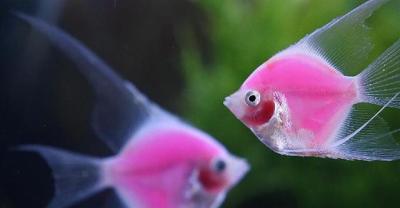
In-depth understanding of the meaning of impatiens so that the cultured leaves are greener.
Impatiens in the folk is also known as peach red or henna, they have a long history in China, and now the friends who plant this kind of flowers are better than.
- Next

There are hanging orchids at home, you need to know these breeding skills!
Hanging orchid has a strong function of absorbing harmful gases, if it is a new house decoration, must put more pots of hanging orchid at home, in order to purify indoor air, absorb.
Related
- On the eggshell is a badge full of pride. British Poultry Egg Market and Consumer observation
- British study: 72% of Britons are willing to buy native eggs raised by insects
- Guidelines for friendly egg production revised the increase of space in chicken sheds can not be forced to change feathers and lay eggs.
- Risk of delay in customs clearance Australia suspends lobster exports to China
- Pig semen-the Vector of virus Transmission (4)
- Pig semen-the Vector of virus Transmission (3)
- Five common causes of difficult control of classical swine fever in clinic and their countermeasures
- Foot-and-mouth disease is the most effective way to prevent it!
- PED is the number one killer of piglets and has to be guarded against in autumn and winter.
- What is "yellow fat pig"? Have you ever heard the pig collector talk about "yellow fat pig"?

